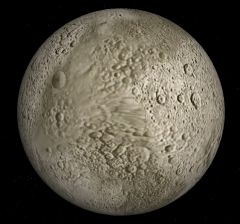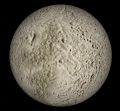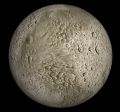Tarvos
Jump to navigation
Jump to search
Tarvos (Saturn XXI, S/2000 S 4) is one of the outer prograde irregular moons of Saturn. It was discovered by John J. Kavelaars et al in 2000. It is named for a bull god in Celtic mythology.
Tarvos in Orbiter
Tarvos was first introduced into Orbiter with the add-on saturn_iv.zip in February 2003. Note that Tarvos is provided by the add-on as S/2000-S4. To simulate it as Tarvos, the following changes need to be made.
- File:S2000_S4.cfg:
- change the filename to Tarvos.cfg
- change the name in the comment line in the top line to Tarvos (S/2000-S4, Saturn)
- line 3, change NAME = to Tarvos
- Last line, change the name of Base1 = to Tarvos
- File:S4-Station.cfg
- change the filename to Tarvos-station.cfg
- Line 3, change the name to Tarvos-Station
- File:Saturn_S2000S4.scn
- change the filename to Saturn_Tarvos.scn
- Line 2, change S12 Station to Tarvos Station
- Find the GL-01 ship, change STATUS Landed S2000-S4 to Landed Tarvos
- Change BASE S4-Station:1 to Tarvos-Station:1
- File:S2000-S4.tex, change filename to Tarvos.tex
- File:S2000-S4M.BMP, change filename to TarvosM.BMP
| Add-on | Source | Version | Author | Type | Release Date | Compatibility | Wiki article |
|---|---|---|---|---|---|---|---|
| The Outer Planets 060929 Base | AVSIM | Rolf Keibel Carl Romanik Tony Dunn |
Scenery | 30 September 2006 | Orbiter 2006-P1 | ||
| The Outer Planets 050125 | AVSIM | 050125 | Rolf Keibel Tony Dunn |
Scenery | 26 January 2005 | Orbiter 2005-P1 | |
| Saturn's Moons Part IV | AVSIM | Rolf B Keibel | Scenery | 6 February 2003 | |||
See also
Gallery
Animation of three discovery images of Tarvos taken by the 3.6 meter Canada-France-Hawaii Telescope on 23 September 2000
from Wikimedia Commons
| edit The Solar System | |
|---|---|
| Central star |
Sun (Sol) |
| Planets |
Mercury - Venus - Earth - Mars - Jupiter - Saturn - Uranus - Neptune |
| Natural satellites |
Moon - Phobos - Deimos - Io - Europa - Ganymede - Titan - more... |
| Add-ons |
Planets - Dwarf Planets - Small objects - Natural satellites - Alternative star systems |
 | This natural satellite related article is a stub. You can help Orbiterwiki by expanding it.
|




